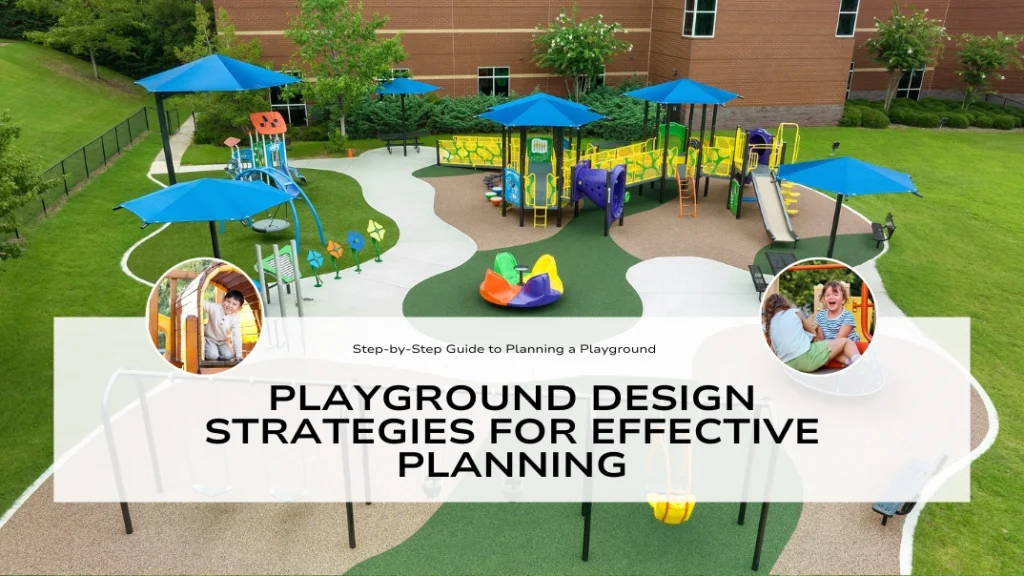Designing a playground involves more than just fun equipment—it requires a strategic approach to meet children’s developmental needs, adhere to safety regulations, and ensure accessibility. A playground design must be functional, safe, and stimulating, allowing children of all ages and abilities to engage in physical, social, and cognitive development.
A well-executed playground design prioritizes both safety and creativity. Combining the right equipment, thoughtful layout, and adherence to international safety standards creates an environment where children thrive. This comprehensive guide outlines critical strategies for designing a safe, functional, and fun playground, ensuring it meets the needs of children, caregivers, and communities.
By following these strategies, you’ll be equipped to create a playground that supports children’s holistic growth while adhering to best practices in safety and design. Let’s start by understanding the core components of an effective playground.
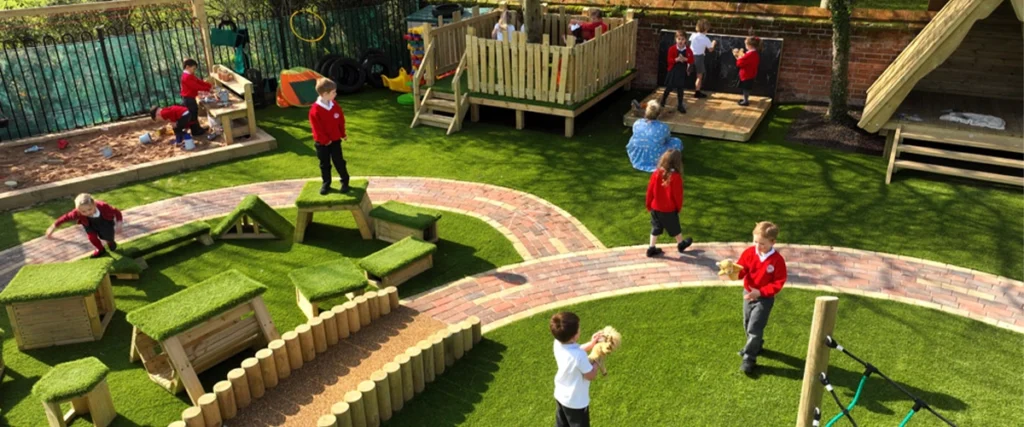
How Playgrounds Support Gross Motor Skill Development
Why are motor skills essential in playground design?
Through active play, children develop critical gross motor skills—such as walking, climbing, balancing, skipping, and jumping. A well-rounded playground design incorporates equipment that promotes these skills, helping children develop physical strength, coordination, and endurance. This is particularly important in preschool playground designs, where early childhood development is the primary focus.
Walking
Walking paths are a fundamental aspect of any playground layout design. They encourage children to move around freely, enhancing their coordination and balance. Incorporating a variety of textures like grass, rubber, and mulch in playground designs for backyards or larger outdoor playground designs can provide sensory experiences that improve children’s foot strength and balance.
Climbing
Climbing structures, such as rock walls and rope nets, are crucial in building upper body strength and improving coordination. For more adventurous spaces, adventure playground designs might include more challenging climbing equipment, providing varying degrees of difficulty for children of different ages. Backyard playground designs can consist of smaller climbing frames that offer enough challenge to keep kids engaged.
Balancing
Balancing activities is essential for developing core strength and focus. Balance beams, stepping stones, and wobbly bridges are standard in both preschool playground design and natural playground designs. Incorporating natural elements like logs or rocks for balancing fosters coordination and fits nicely into a natural playground design aesthetic.
Skipping and Jumping
Skipping and jumping are great ways to develop cardiovascular health and coordination. Integrating equipment like trampolines or hopscotch into your playground design encourages these activities. Playground design ideas for preschoolers include low platforms for safe jumping, while natural playground designs can feature tree stumps or uneven terrain for more dynamic play.
By considering these activities, your playground design will encourage the physical development of children, supporting healthy growth in a fun and engaging way. Incorporating these elements into early childhood playground designs ensures that your playground is entertaining and developmentally beneficial.
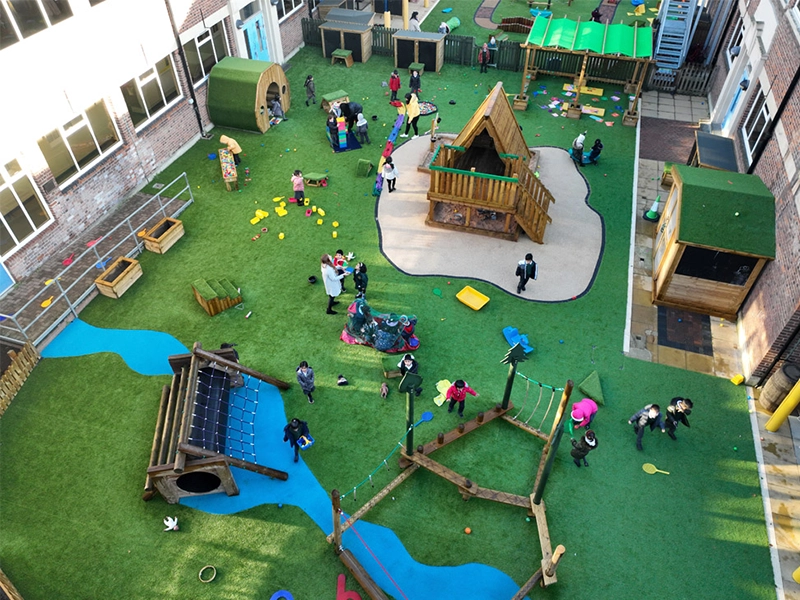
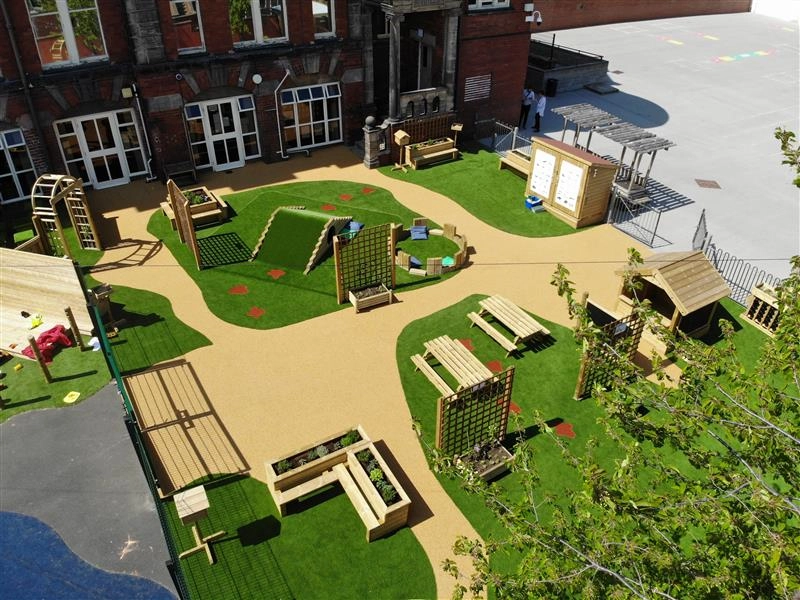
Key Safety Guidelines for Effective Playground Design
What safety standards should your playground design follow?
Safety is paramount in any playground design. Following international and national safety regulations is essential to ensure that children can play without risk. These standards vary slightly from country to country but share common principles designed to reduce accidents and ensure safe play.
United States Standards (ASTM & CPSC)
In the United States, playground design must comply with standards set by ASTM International (formerly the American Society for Testing and Materials) and the U.S. Consumer Product Safety Commission (CPSC). ASTM F1487 is the primary standard for public playground equipment, focusing on safety performance and specifications. The CPSC’s Public Playground Safety Handbook provides guidelines on fall height, impact surfaces, and equipment spacing to prevent injuries.
European Union Standards (EN 1176 & EN 1177)
The European Union adheres to EN 1176 and EN 1177 standards for playground safety. EN 1176 focuses on equipment safety, including swings, slides, and climbing frames, while EN 1177 emphasizes impact-absorbing surfaces. These standards apply to all outdoor playground designs and are essential for minimizing fall-related injuries. Inclusive playground designs in Europe must also meet accessibility requirements under these standards.
Australian Standards (AS 4685 & AS 4422)
Australia follows AS 4685 for playground equipment and AS 4422 for playground surfacing. These standards outline the requirements for safe equipment, proper spacing, and impact-absorbing materials. Australian guidelines emphasize the importance of ensuring that all equipment in a playground design is suited for the intended age group and provides safe access for children of all abilities.
Other International Guidelines
Countries like Canada and the UK have similar safety requirements, often referencing the U.S. or European standards. For instance, playground design guidelines in Canada closely follow ASTM standards, while the UK adheres to BS EN 1176, the British equivalent of European norms.
Specific Playground Design Elements to Ensure Safety:
Equipment Spacing
Proper spacing between equipment is essential to prevent accidents. Whether you are designing playgrounds for schools or backyard playgrounds, adequate spacing reduces the chance of collisions and promotes safe, independent play. In preschool playground designs, it’s essential to ensure that younger children have enough room to explore without risk of injury from nearby equipment.
Impact-Absorbing Surfaces
The surface beneath the playground equipment must be designed to absorb impact during falls. This is a critical component of any accessible playground design. Common materials include rubber mats, sand, or wood chips, which reduce the severity of falls and protect children from serious injury. For water playground designs, non-slip surfaces are vital to preventing accidents related to wet conditions.
Maintenance and Regular Inspections
Routine inspections are necessary to ensure that the playground remains safe over time. Worn-out equipment, loose bolts, or degraded surfacing can create hazards, so it’s crucial to schedule regular maintenance. This applies to all playground design projects, whether small backyard playground designs or more extensive public playgrounds in schools or parks.
Adhering to these international standards and guidelines ensures your playground design is as safe as fun, providing a secure environment where children can explore and play without risk.


A Variety of Play Equipment for Engaging Playground Designs
Why is diverse equipment necessary in a playground design?
The success of a playground often depends on the variety of equipment available. A playground design that offers different activities appeals to a broader age group and helps children develop various physical, social, and cognitive skills. Whether creating a preschool or adventure playground design, incorporating diverse equipment ensures that children remain engaged and challenged.
Climbing Structures
Climbing promotes physical strength and problem-solving abilities. In a 3D playground design, climbing elements like rope nets, rock walls, or ladders can be layered to create a multi-dimensional play experience. Adventure playground designs often focus on these elements to encourage exploration and challenge. Even in small playground designs, compact climbing structures can keep children entertained while developing their physical skills.
Slides
Slides are a playground staple that helps children develop balance and body awareness. Including a range of slides—straight, spiral, and tunnel—in your playground design layout adds variety and excitement. Playground design ideas for preschoolers can focus on lower slides with gentle slopes, while older children might enjoy faster, taller slides. Integrating slides into natural playground designs—such as embedding them into hillsides—can create a seamless, aesthetically pleasing play environment.
Swings
Swings promote coordination and balance, offering a relaxing and exhilarating play experience. In inclusive playground designs, it’s essential to ensure swings are accessible to children with disabilities. Adding different types of swings, such as tire swings, bucket swings, and basket swings, in your outdoor playground design ensures that children of all ages and abilities can enjoy the experience. For a backyard playground design, swings can be attached to trees or free-standing frames.
Imaginative Play Zones
Imaginative play equipment, such as playhouses, pretend shops, or themed areas, stimulates creativity and social development. Creative playground designs often feature areas dedicated to imaginative play, such as castles, pirate ships, or space stations. This encourages children to engage in role-playing, storytelling, and cooperative play. Custom playground designs can integrate unique themes that reflect local culture or history, offering a genuinely bespoke play experience.
Free Play Areas
Incorporating open areas for free play allows children to create games, run freely, and explore at their own pace. Natural playground designs often feature large open spaces with natural elements like trees, water features, or sand pits. These areas provide opportunities for unstructured play, which is crucial for social development. In smaller indoor playground designs, open spaces can be used for group games, soft play, or interactive panels.
A diverse range of equipment in your playground design encourages physical, cognitive, and social growth while keeping children entertained and engaged.
Your perfect classroom is one click away!
Customizing Your Playground Design for Optimal Results
How can you customize a playground for your needs?
Customization allows you to design a playground that reflects your community’s needs and identity. Whether you are working on a small or a larger 3D playground design, customization ensures that the space is tailored to meet local preferences, age groups, and available space.
Complete Play Systems
Complete play systems offer a cohesive, ready-to-install solution for larger playground design projects. These systems include various interconnected play elements—such as swings, slides, and climbing structures—that create a complete play environment. Preschool playground designs can benefit from modular play systems that provide all the necessary features in one compact package.
Adding New Components
If you already have an established playground, adding new features can refresh the space and attract new users. For example, integrating water playground designs or sensory play panels can enhance the appeal of your playground design without requiring a complete redesign. In backyard playground designs, adding simple elements like sandboxes or interactive panels can breathe new life into an existing space.
Custom Design
Custom playground design ideas offer flexibility and creativity. Whether you are designing a new playground for a city park or upgrading a school playground, custom designs can reflect the area’s unique cultural or geographical aspects. Innovative playground designs often incorporate unique features like obstacle courses, multi-sensory zones, or nature trails, making the space more dynamic and exciting. Providing a unique space that encourages exploration and engagement.
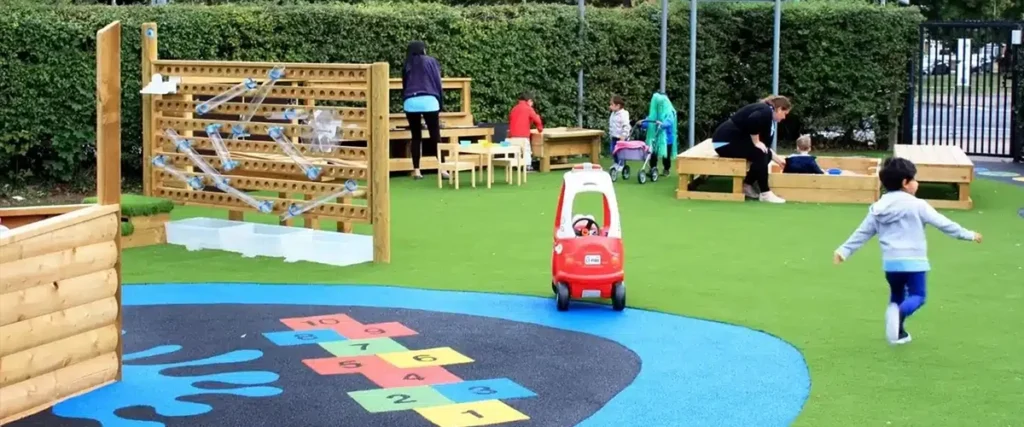
Step-by-Step Guide to Planning a Playground
Step 1: How to Budget and Apply for Funding?
Budgeting is essential for any playground design project. Without a well-defined budget, costs can quickly escalate. Here’s how to handle budgeting:
- Identify funding sources: Government grants, community fundraising, and corporate sponsorships are all viable funding options for playground design.
- Itemize expenses: Break down all costs, including equipment, installation, safety surfacing, and maintenance. This is especially important in inclusive playground designs, which may require specialized equipment.
- Plan for ongoing costs: Playground designs require regular maintenance to remain safe. Make sure your budget accounts for future inspections, repairs, and replacements.
Step 2: How to Choose the Desired Playground Style?
Choosing the right style for your playground is critical because it impacts the look, feel, and kids’ engagement with the space. The style sets the tone for the overall experience, so it’s essential to select one that matches the location and purpose of the playground. Below are three popular playground styles, each with its unique benefits and considerations:
- Natural Wooden Aesthetic: This style blends the playground with its natural surroundings. Using eco-friendly materials like wood, logs, or rope, this style gives the playground a warm, organic feel, making it ideal for parks, nature reserves, and schools focused on outdoor education. It promotes a connection to nature and can include features like treehouses, wooden swings, or log balance beams.
- Why Choose It: Perfect for natural playground designs, this style encourages outdoor exploration and imaginative play while supporting environmental sustainability.
- Considerations: Wooden structures may require more maintenance over time (like weatherproofing or pest control), but they create a timeless, natural play space that appeals to children and adults.
- Classic Playground Aesthetic: This design is the most recognizable with its bright, colorful plastic and metal equipment, often seen in urban parks, schoolyards, and public spaces. These playgrounds typically feature swings, slides, monkey bars, and see-saws. Classic playgrounds are designed to be visually appealing, highly durable, and accommodate many children simultaneously.
- Why Choose It: Ideal for preschool playground design ideas, this style is excellent for high-traffic areas where durability and safety are paramount. It’s perfect for spaces where bright colors and engaging visuals are needed to attract children.
- Considerations: While vibrant and fun, this style may not blend well with natural surroundings. However, its durability and low-maintenance requirements make it a top choice for public spaces.
- Futuristic Playground Aesthetic: For those looking to create a more modern, tech-savvy space, the futuristic playground style focuses on innovation and interactive play. These playgrounds often feature sleek, minimalist designs and cutting-edge materials like smooth metal, synthetic surfaces, and interactive digital elements (e.g., sound panels, motion sensors, or augmented reality features).
- Why Choose It: Perfect for modern indoor playground designs or urban environments, this style provides a forward-thinking approach to play. It encourages creativity through technology and new play methods.
- Considerations: While futuristic playgrounds are visually striking and interactive, they can be more expensive to install and maintain due to their use of advanced materials and technology. They are ideal for communities focused on tech innovation and education.
By choosing a playground-style that fits your community’s goals and environment, you create a cohesive play experience that enhances the space and draws children in. Whether natural, classic, or futuristic, each style uniquely engages children and encourages exploration.
Don’t just dream it, design it! Let’s chat about your custom furniture needs!
Step 3: How to Address the Needs of Your Target Audience?
A successful playground design must consider the children’s specific needs. Different age groups require different types of play equipment, and creating spaces that entertain and support their developmental needs is essential. Here’s how you can design a playground that caters to various age groups:
- 1-3-Year-Olds: This age group requires safe, low-to-the-ground equipment that allows them to explore at their own pace. Equipment should focus on developing fundamental motor skills like crawling, walking, and balancing.
- Playground Features: Crawl tunnels, small slides, and sensory play panels are ideal. Soft surfaces and brightly colored elements can help stimulate their senses while keeping them safe. For preschool playground designs, incorporating features like interactive touch panels, small ramps, and tactile surfaces encourages exploration and hands-on learning.
- Why It’s Important: This stage is all about early development—learning to move, touch, and interact with the environment in a safe and controlled way.
- 3-6-Year-Olds: Children in this age range are highly imaginative and love engaging in role-play and cooperative play. They need spaces that allow them to create stories, solve simple problems, and explore different types of movement.
- Playground Features: Include imaginative play areas like playhouses, small climbing structures, balance beams, and pretend play zones (like a pirate ship or market stall). Low climbing walls and obstacle courses provide both physical and creative challenges.
- Why It’s Important: Children build social skills at this stage and love engaging in imaginative play with peers. Playground designs should encourage creativity and cooperation while still ensuring safety.
- 6-9-Year-Olds: This age group needs more physically challenging play options. Kids are developing strength, coordination, and problem-solving abilities, so providing equipment that encourages them to push their limits safely is essential.
- Playground Features: Add complex climbing frames, monkey bars, zip lines, obstacle courses, and rope ladders. These features challenge children to use their muscles and coordination in new ways while having fun. Large group swings or spinning equipment are also significant for this age.
- Why It’s Important: Children at this stage are testing their physical abilities, and they need equipment that helps them grow more robust, more coordinated, and more confident.
- 9-12-Year-Olds: Older children enjoy independence and the chance to engage in more advanced physical challenges or group activities. This age group often appreciates playground spaces that offer physical excitement and social interaction.
- Playground Features: Incorporate more advanced equipment like rope courses, zip lines, climbing towers, or spinning rides. Adding seating areas where children can gather with friends, talk, or watch others play is also an excellent addition for this age group.
- Why It’s Important: Pre-teens seek more challenging play and socializing opportunities. Designing playground spaces with this in mind helps keep them engaged while also promoting physical fitness.
By tailoring the playground to these different age groups, you ensure that your playground design appeals to a wide range of children, making it a hub for fun and development. Ensuring spaces for physical activity and imaginative play helps support kids’ cognitive, physical, and social growth across all age groups.
Step 4: How to Define the Purpose of Your Playground?
The purpose of your playground will influence its design and layout. Whether it’s promoting fitness, social interaction, or imaginative play, defining the playground’s goals ensures the space meets its objectives.
Step 5: How to Zone Your Playground Effectively?
Zoning ensures that your playground design is safe and functional. Active areas—such as swings and climbing zones—should be separated from quieter areas like reading corners or sensory play zones to prevent overcrowding and accidents.
Step 6: Understanding Playground Safety and Regulations
Safety regulations vary by region, but the fundamental principles remain the same. Ensure that equipment is age-appropriate, impact-absorbing surfaces are in place, and regular maintenance is performed. Adhering to safety guidelines in your playground design ensures that children can play freely without risk of injury.

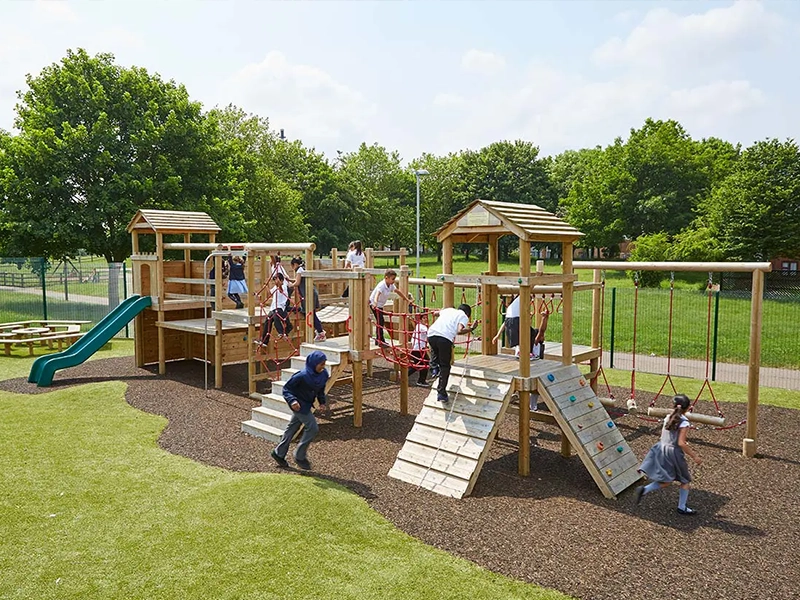
High-quality playground Equipment from Xiair World
At Xiair World, we provide custom playground solutions that are safe, durable, and engaging for children of all ages. From small playground designs to larger inclusive playground designs, we ensure that every playground is designed to foster physical, social, and cognitive development.
Why Choose Xiair World?
Customization
Our playground designs are fully customizable, allowing you to create a space that reflects the unique needs of your community. Whether you are making a preschool playground design or a modern indoor playground, we offer flexible solutions tailored to your project.
Safety-First Approach
Our equipment exceeds international safety standards, ensuring your playground is safe for children of all ages. Whether you’re working on a new playground design or improving an existing one, safety remains our top priority.
Innovative Designs
We provide cutting-edge 3D and natural playground designs that engage children and encourage exploration. Our indoor playground interior design services can help you transform any indoor space into a dynamic play area.
Eco-Friendly Materials
We use sustainable materials to ensure that your playground design is safe for children and environmentally responsible. This is particularly important in natural playground designs, where eco-conscious choices are essential.
Your perfect classroom is one click away!
Conclusion
A successful playground design requires careful planning, adherence to safety standards, and consideration of the children using the space. Following the strategies outlined in this guide and working with a trusted provider like Xiair World, you can create a safe, engaging, and developmentally appropriate playground for children. Whether you are designing a preschool playground layout or a large public playground design project, the right approach ensures that the space will serve as a fun, enriching environment for years.

